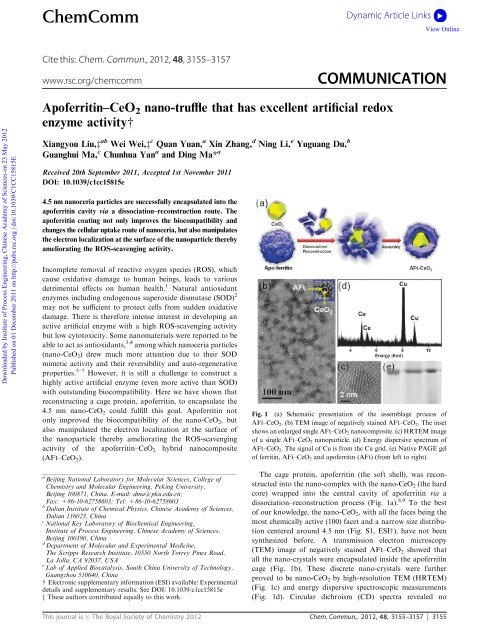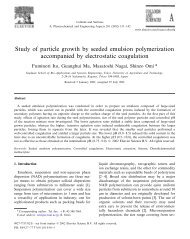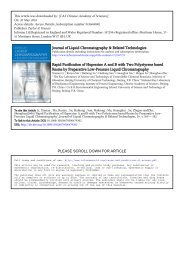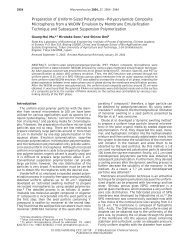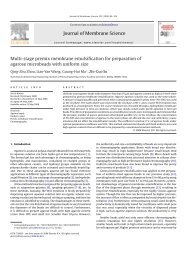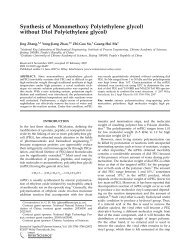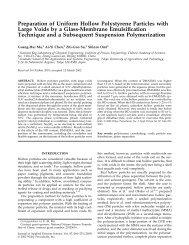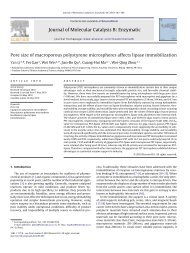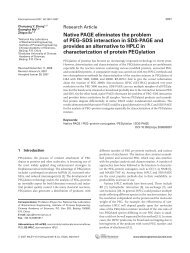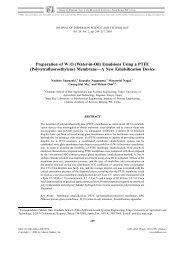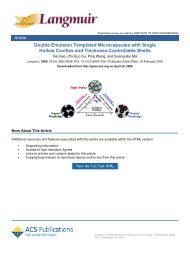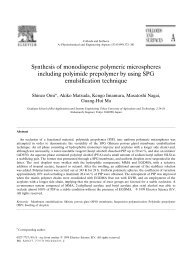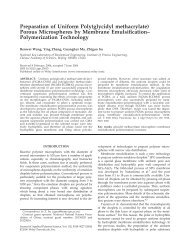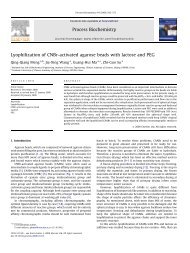Apoferritin–CeO2 nano-truffle that has excellent artificial redox ...
Apoferritin–CeO2 nano-truffle that has excellent artificial redox ...
Apoferritin–CeO2 nano-truffle that has excellent artificial redox ...
You also want an ePaper? Increase the reach of your titles
YUMPU automatically turns print PDFs into web optimized ePapers that Google loves.
Downloaded by Institute of Process Engineering, Chinese Academy of Sciences on 23 May 2012<br />
Published on 01 December 2011 on http://pubs.rsc.org | doi:10.1039/C1CC15815E<br />
ChemComm<br />
Cite this: Chem. Commun., 2012, 48, 3155–3157<br />
Apoferritin–CeO 2 <strong>nano</strong>-<strong>truffle</strong> <strong>that</strong> <strong>has</strong> <strong>excellent</strong> <strong>artificial</strong> <strong>redox</strong><br />
enzyme activityw<br />
Xiangyou Liu,z ab Wei Wei,z c Quan Yuan, a Xin Zhang, d Ning Li, e Yuguang Du, b<br />
Guanghui Ma, c Chunhua Yan a and Ding Ma* a<br />
Received 20th September 2011, Accepted 1st November 2011<br />
DOI: 10.1039/c1cc15815e<br />
4.5 nm <strong>nano</strong>ceria particles are successfully encapsulated into the<br />
apoferritin cavity via a dissociation–reconstruction route. The<br />
apoferritin coating not only improves the biocompatibility and<br />
changes the cellular uptake route of <strong>nano</strong>ceria, but also manipulates<br />
the electron localization at the surface of the <strong>nano</strong>particle thereby<br />
ameliorating the ROS-scavenging activity.<br />
Incomplete removal of reactive oxygen species (ROS), which<br />
cause oxidative damage to human beings, leads to various<br />
detrimental effects on human health. 1 Natural antioxidant<br />
enzymes including endogenous superoxide dismutase (SOD) 2<br />
may not be sufficient to protect cells from sudden oxidative<br />
damage. There is therefore intense interest in developing an<br />
active <strong>artificial</strong> enzyme with a high ROS-scavenging activity<br />
but low cytotoxicity. Some <strong>nano</strong>materials were reported to be<br />
able to act as antioxidants, 3,4 among which <strong>nano</strong>ceria particles<br />
(<strong>nano</strong>-CeO2) drew much more attention due to their SOD<br />
mimetic activity and their reversibility and auto-regenerative<br />
properties. 5–7 However, it is still a challenge to construct a<br />
highly active <strong>artificial</strong> enzyme (even more active than SOD)<br />
with outstanding biocompatibility. Here we have shown <strong>that</strong><br />
reconstructing a cage protein, apoferritin, to encapsulate the<br />
4.5 nm <strong>nano</strong>-CeO 2 could fulfill this goal. Apoferritin not<br />
only improved the biocompatibility of the <strong>nano</strong>-CeO 2, but<br />
also manipulated the electron localization at the surface of<br />
the <strong>nano</strong>particle thereby ameliorating the ROS-scavenging<br />
activity of the apoferritin–CeO2 hybrid <strong>nano</strong>composite<br />
(AFt–CeO2).<br />
a Beijing National Laboratory for Molecular Sciences, College of<br />
Chemistry and Molecular Engineering, Peking University,<br />
Beijing 100871, China. E-mail: dma@pku.edu.cn;<br />
Fax: +86-10-62758603; Tel: +86-10-62758603<br />
b Dalian Institute of Chemical Physics, Chinese Academy of Sciences,<br />
Dalian 116023, China<br />
c National Key Laboratory of Biochemical Engineering,<br />
Institute of Process Engineering, Chinese Academy of Sciences,<br />
Beijing 100190, China<br />
d Department of Molecular and Experimental Medicine,<br />
The Scripps Research Institute, 10550 North Torrey Pines Road,<br />
La Jolla, CA 92037, USA<br />
e Lab of Applied Biocatalysis, South China University of Technology,<br />
Guangzhou 510640, China<br />
w Electronic supplementary information (ESI) available: Experimental<br />
details and supplementary results. See DOI: 10.1039/c1cc15815e<br />
z These authors contributed equally to this work.<br />
Dynamic Article Links<br />
View Online<br />
www.rsc.org/chemcomm COMMUNICATION<br />
Fig. 1 (a) Schematic presentation of the assemblage process of<br />
AFt–CeO2. (b) TEM image of negatively stained AFt–CeO2. Theinset<br />
shows an enlarged single AFt–CeO 2 <strong>nano</strong>composite. (c) HRTEM image<br />
of a single AFt–CeO2 <strong>nano</strong>particle. (d) Energy dispersive spectrum of<br />
AFt–CeO 2. The signal of Cu is from the Cu grid. (e) Native PAGE gel<br />
of ferritin, AFt–CeO2 and apoferritin (AFt) (from left to right).<br />
The cage protein, apoferritin (the soft shell), was reconstructed<br />
into the <strong>nano</strong>-complex with the <strong>nano</strong>-CeO2 (the hard<br />
core) wrapped into the central cavity of apoferritin via a<br />
dissociation–reconstruction process (Fig. 1a). 8,9 To the best<br />
of our knowledge, the <strong>nano</strong>-CeO2, with all the faces being the<br />
most chemically active (100) facet and a narrow size distribution<br />
centered around 4.5 nm (Fig. S1, ESIw), have not been<br />
synthesized before. A transmission electron microscopy<br />
(TEM) image of negatively stained AFt–CeO 2 showed <strong>that</strong><br />
all the <strong>nano</strong>-crystals were encapsulated inside the apoferritin<br />
cage (Fig. 1b). These discrete <strong>nano</strong>-crystals were further<br />
proved to be <strong>nano</strong>-CeO2 by high-resolution TEM (HRTEM)<br />
(Fig. 1c) and energy dispersive spectroscopic measurements<br />
(Fig. 1d). Circular dichroism (CD) spectra revealed no<br />
This journal is c The Royal Society of Chemistry 2012 Chem. Commun., 2012, 48, 3155–3157 3155


